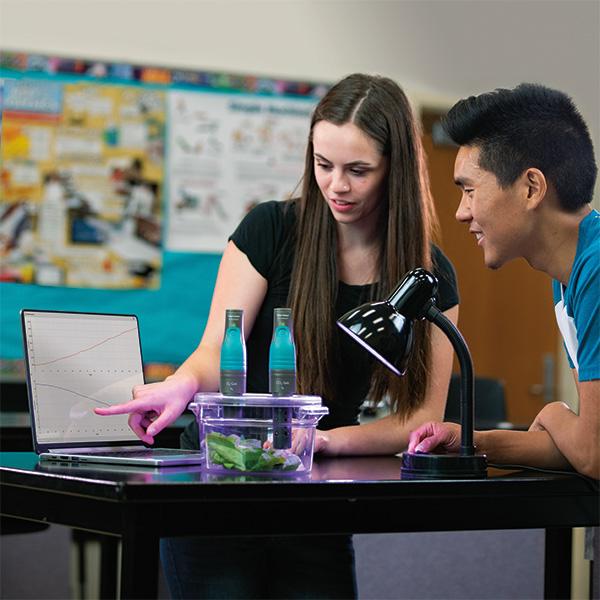
Sharing ideas and inspiration for engagement, inclusion, and excellence in STEM

One of the fundamental concepts in biology is photosynthesis, the process by which plants use carbon dioxide, light, and water to make their own food. Sunlight contains a broad spectrum of wavelengths, both visible and invisible—but plants use only specific parts of the visible spectrum for photosynthesis.
Although light bulbs try to re-create the visible spectrum of sunlight, many lack sufficient intensity at the necessary wavelengths for plants. This can be frustrating when you’re trying to carry out a photosynthesis experiment in your lab or classroom.
So, what is the best light source for experiments that investigate photosynthesis? We used Vernier technology to answer this question.
Due to the types of chlorophyll found in most plants, we know the optimal wavelengths of visible light for photosynthesis fall within the blue range (425–450 nm) and red range (600–700 nm). This means, ideally, the best light sources for photosynthesis should emit light in the blue and red ranges.
Wavelengths of light outside of these two ranges are not used by most plants. Plus, they can contribute to heat buildup in plant tissues, which can damage plants and even interfere with photosynthesis.
To identify the best light source for photosynthesis, we used the Go Direct® SpectroVis® Plus Spectrophotometer, a Vernier Spectrophotometer Optical Fiber, and LabQuest® to collect the output or emission spectra of four kinds of E27 light bulbs:
- 60 W incandescent bulb
- 35 W halogen bulb
- 28 W-equivalent LED “plant bulb” (6–9 W)
- 13 W compact fluorescent light (CFL) bulb
The Vernier tools gave us the ability to determine the wavelengths emitted by each light bulb and get an idea of their relative intensities. We used the same desk lamp to test each bulb. In addition, we measured each bulb at a standard distance of 50 cm.
Which light source was the winner? The LED plant bulb.
This bulb produced a strong output in both the blue and red wavelengths. Additionally, it produced very little additional light in other regions; with the LED plant bulb, heat buildup wasn’t a concern.
The halogen and incandescent bulbs had extremely broad output ranges, from green to deep into the red portion of the spectrum. However, they had little to no output in the blue range.
The least suitable light source for photosynthesis was the CFL bulb. Although it emitted some light in both the blue and red ranges (with several peaks in between), the intensity of this bulb was the weakest compared with the other three.

LED plant lights are available from a variety of online merchants, as well as home and garden stores. They have become very affordable and work well for experiments that investigate photosynthesis.
For more tips and strategies for teaching your students about photosynthesis—and other fundamental biology concepts—contact us at biology@vernier.com or 888-837-6437.
Share this Article

Sign up for our newsletter
Stay in the loop! Beyond Measure delivers monthly updates on the latest news, ideas, and STEM resources from Vernier.






